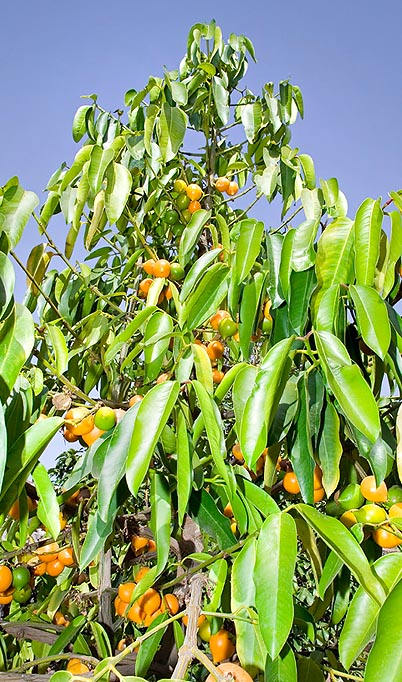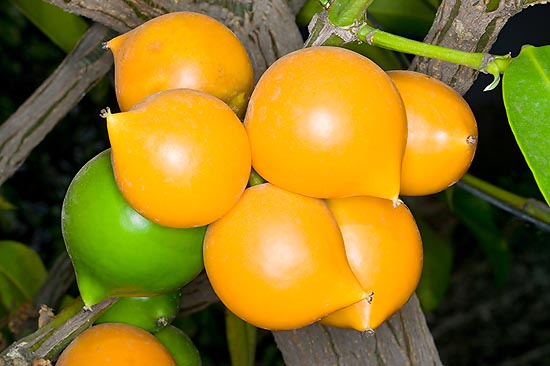Family : Clusiaceae

Text © Pietro Puccio

English translation by Mario Beltramini

The Garcinia xanthochymus is a 10 m pyramidal small tree © G. Mazza
The genus is honoured to the French botanist Laurent Garcin (1683-1751); the name of the species originates from the combination of the Greek words “xanthos” = yellow, and “chymos” = juice, with obvious reference.
Common names: eggtree, false mangosteen, gambogetree, Himalayan garcinia, Mysore gamboge, sour mangosteen, yellow mangosteen (English); gamboge des teinturiers, mangoustan amer (French); mangostão amarelo (Portuguese); gurka, mundu (Spanish).
The Garcinia xanthochymus Hook.f. ex T.Anderson (1874) is a shrub or a small erect tree, tall up to 10 m, much ramified, with horizontal or pendulous branches with quadrangular section and pale brown bark that peels off in small roundish flakes. The leaves are opposite, hanging, oblong, 20-35 cm long and 4-10 cm broad, of a glossy dark green colour.
The inflorescences are cymes which come out at the axilla of the fallen leaves, formed by 2 to 10 flowers of 1,8 cm of diameter with five petals of greenish white colour; the species is diecious (each single plant carries either only male or female flowers), but at times male plants may carry also bisexual flowers.
The fruits, edible, are sub-globular berries with pointed apex, of green colour when unripe, intense yellow when ripe, 5-8 cm long and containing from one to four seeds, but, most frequently, two.
It reproduces by seed which germinates quite easily, but as it has a reduced time of germinating power, it must be planted as soon as possible; the first fructification takes place by around the fifth, sixth year of age; it reproduces also by cutting and by marcotting.
The best climate for its cultivation is the tropical and humid subtropical one, with and annual rainfall of more than 3000 mm. It may be cultivated, marginally, in the warm temperate zones, as it stands, for a short time, temperatures as low as the 0 °C, and giving, during the drought periods and high temperatures, abundant irrigations.
It requires an exposition in full sun or semi-shade; for what the soil is concerned, it is not much particular, provided the same is draining and practically always humid (however, a short period of dryness stimulates its blooming).
The fruits, quite rich in vitamin C, have a bittersweet taste deemed much palatable by many and are consumed fresh with sugar or employed for preparing jams.

The fruits, green and then yellow, are quite rich in vitamin C © Giuseppe Mazza
Extracts of various parts of the plant are used in the traditional medicine.
Laboratory studies have shown, amongst other things, the presence in the leaves of particular polyphenols, the xanthones, which hold promising pharmacological anti-oxidant, anti-inflammatory, anti-cancer and anti-microbial properties. Finally, the species is often utilized as rootstock for the Garcinia mangostana.
Synonyms: Xanthochymus pictorius Roxb. (1805); Xanthochymus tinctorius DC. (1824); Garcinia roxburghii Kurz (1875); Garcinia tinctoria (DC.) W.Wight (1909); Garcinia pictoria (Roxb.) Dunn (1915); Garcinia tinctoria (DC.) Dunn (1915); Garcinia pictoria (Roxb.) Engl. (1925).
→ To appreciate the biodiversity within the CLUSIACEAE family please click here.
